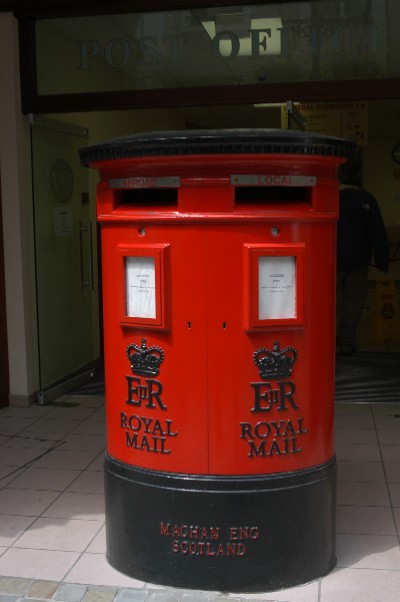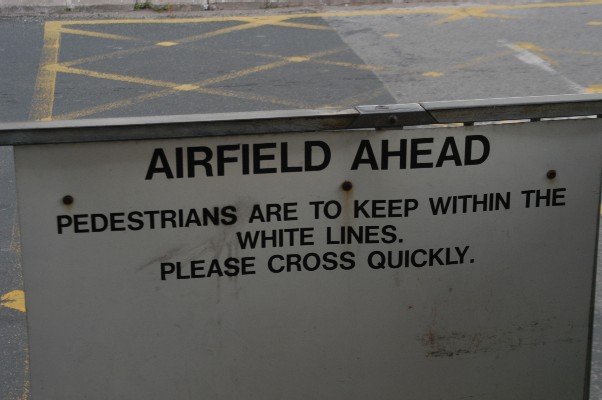April 29. GIBRALTAR We could see the big rock from Algeciras, looking a bit like the shape of a person lying down. The Greeks thought it was one of the pillars of Hercules with its sister pillar positioned on the coast of Morocco, together marking the edge of the known world. The Phoenicians sailed past the "edge of the known world" and  also left their traces on Gibraltar. But it was from the leader of the Muslim invasion of the Iberian peninsula in 711 that the island received its name. Gibraltar was derived from Jebel Tariq, meaning Tariq's mountain, after the Muslim leader Tariq ibn Ziyad. also left their traces on Gibraltar. But it was from the leader of the Muslim invasion of the Iberian peninsula in 711 that the island received its name. Gibraltar was derived from Jebel Tariq, meaning Tariq's mountain, after the Muslim leader Tariq ibn Ziyad.
Gibraltar remained in Muslim hands until the Spanish Castile took it in 1462. In 1704 Gibraltar was captured by an Anglo-Dutch fleet during the War of the Spanish Succession. Spain officially ceded the Rock of Gibraltar to Britain in 1713 but made military attempts to regain it until 1783. It was a important strategic position for Britain in WWII, when most of the local population was evacuated to Britain, Madeira, and Jamaica. This year Gibraltar is celebrating its 300th year as a British colony but Spain still wants the Rock back. (Spain doesn't want to give Morocco back the two colonies it has had on North Africa since 1640 but it thinks it should have Gibraltar back.) But, in 1969 the people of Gibraltar voted 12,138 to 44 in favor of British sovereignty over Spanish and made it a requirement that the people of Gibraltar be able to vote on any changes to their status in the future. It now maintains self government and its own parliament under Britain. Spain still tried to negotiate Gibraltar away from Britain but the British government has said it will not relinquish Gibraltar's status against local wishes. At 300 years running the issue will certainly continue to resurface.
In spite of Gibraltar's preference for British sovereignty it can's help but be influenced by its only bordering neighbor. The population of the island is 77% Gibraltarians, 14% British, and 9% from other nationalities. But, Gibraltarians have been derived from the people of British, Spanish, Genoese, and Jewish decent that originally colonized the island. The population is bilingual in English and Spanish and have naturally mingled to tow into their own dialect. For example, library in Spanish is biblioteca but on Gibraltar they call it a libreria.  Still, the hours kept by shops are consistent with British culture, closing around 5:00, and there is no shortage of pubs and places to eat a hearty English breakfast. Still, the hours kept by shops are consistent with British culture, closing around 5:00, and there is no shortage of pubs and places to eat a hearty English breakfast.
We just had a half hour bus ride to the border town of La Linea de la Concepcion where we made a short walk to the Spanish-Gibraltar border. The passport check was quick and with a simple map provided by the tourist office we were ready for our day in Gibraltar. But, to actually reach the downtown area we still had to cross Gibraltar's massive airport runway. Being mostly a big rock, Gibraltar's airport has been built on the only flat stretch of land that stands between the rock and Spain. A pedestrian light gave us the go ahead to cross and a nearby sign encouraged people to move quickly.
On the other side of the runway we followed signs through the Landport tunnel, once the only land entry through the fortified walls. The tunnel led us to a large square that open up to Gibraltar's pedestrian Main Street. The architecture was certainly reminiscent of Britain and the street was packed with people. Being a small place it seemed that Gibraltar made itself an attractive duty-free shopping destination and the colorful streets were lined with shops selling all kinds of luxury goods from fancy perfume to Lladro figurines.
Our first priority was to find a good breakfast. We'd had enough of this bread and coffee for breakfast business. It didn't take long to find a pub just off Main Street that served us up a heart stopping and artery clogging breakfast of sausages , bacon, fried bread, baked beans, sautéed mushrooms, a fried egg, and that mandatory jiggley tomato. Rob had died and gone to heaven. We wrote some postcards over breakfast and then set off to explore the town. , bacon, fried bread, baked beans, sautéed mushrooms, a fried egg, and that mandatory jiggley tomato. Rob had died and gone to heaven. We wrote some postcards over breakfast and then set off to explore the town.
The length of Gibraltar town can be pretty much walked in about fifteen minutes. We weren't looking for duty free shopping but did search out the bookstores for some English publications. The weather was looking uncertain so after a quick shandy break we walked to the end of town to catch the tram. Taking the tram up to the top of the rock to see the view and Gibraltar's famous Barbary apes, Europe's only wild apes, was the Rock's highlight. We bought our ticket but by the time we got to the front of the queue we were told that they had to shut the tram down for the day due to high winds. We could have caught a cab up the mountain for a rather fat sum but opted not to go. That left us with the afternoon to kill. The good news was that the weather cleared, just not the wind, so we had a nice afternoon just walking around town, taking in an English tea and visiting the Gibraltar museum.
The museum house a nice little collection of exhibits covering Gibraltar's history.  The earliest Neanderthal human discovered in Europe was actually from Gibraltar. Unfortunately the skull found on Gibraltar sat collecting dust until after the discover of early human remains in Germany's Neander Valley. So, Neanderthal man should actually have been Gibraltar woman. Gibraltar was also where Admiral Nelson's body was brought ashore after the legendary Battle of Trafalgar. The earliest Neanderthal human discovered in Europe was actually from Gibraltar. Unfortunately the skull found on Gibraltar sat collecting dust until after the discover of early human remains in Germany's Neander Valley. So, Neanderthal man should actually have been Gibraltar woman. Gibraltar was also where Admiral Nelson's body was brought ashore after the legendary Battle of Trafalgar.
Before it got too late in the day we made a nice long walk along the coast to Europa Point, the southern tip of the peninsula where a Christian Shrine to Our Lady of Europe stands near the Mosque of the Custodian of Two Holy Mosques. The later claims to be the largest mosque in a non-Muslim country. Other than the buildings and the distant view over to Africa there wasn't much else to see at the point and grabbed a bus back into Gibraltar town where we finished our day with dinner at a pub in Irish Town. The meal just consumed our last ten Gibraltar pounds.
Walking back to the border we were stopped at the runway while a plane took off. It was rather exciting watching the police face off the oncoming traffic. Just to make sure that nobody could break through the barrier they rolled a truck with armed police up in front of the cars and extended a spiked chain across the street. Once the plane had taken off the police cleared out and traffic began to move again. When we entered through immigration in the morning Rob had asked for a passport stamp. The official just waived us past and said we could get one on the way out. Naturally he had lied and they did little more than glance at  our passports as we exited. So, we crossed the street and went back through immigration again, this time being persistent about the passport stamp. The pedestrian traffic into Gibraltar was slow so they obliged. Then we crossed the street again and re-exited. our passports as we exited. So, we crossed the street and went back through immigration again, this time being persistent about the passport stamp. The pedestrian traffic into Gibraltar was slow so they obliged. Then we crossed the street again and re-exited.
Leaving Gibraltar the town was pretty much closed for the day but back in Spain everyone was just coming out for the evening. We walked around Algeciras until we found the spiffy new Corte Ingles and did some shopping before going to bed. |

